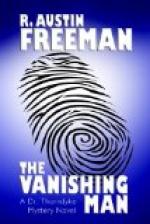“At the very moment when my client’s case seemed almost hopeless, some human remains were discovered at Sidcup. I read the account of the discovery in the evening paper, and, scanty as the report was, it recorded enough facts to convince me that the inevitable mistake had been made.”
“Did it, indeed?” said Mr. Jellicoe. “A mere, inexpert, hearsay report! I should have supposed it to be quite valueless from a scientific point of view.”
“So it was,” said Thorndyke. “But it gave the date of the discovery and the locality, and it also mentioned what bones had been found. Which were all vital facts. Take the question of time. These remains, after lying perdu for two years, suddenly come to light just as the parties—who have also been lying perdu—have begun to take action in respect of the will; in fact, within a week or two of the hearing of the application. It was certainly a remarkable coincidence. And when the circumstances that occasioned the discovery were considered, the coincidence became still more remarkable. For these remains were found on land actually belonging to John Bellingham, and their discovery resulted from certain operations (the clearing of the watercress-beds) carried out on behalf of the absent landlord. But by whose orders were those works undertaken? Clearly by the orders of the landlord’s agent. But the landlord’s agent was known to be Mr. Jellicoe. Therefore these remains were brought to light at this peculiarly opportune moment by the action of Mr. Jellicoe. The coincidence, I say again, was very remarkable.
“But what instantly arrested my attention on reading the newspaper report was the unusual manner in which the arm had been separated; for, besides the bones of the arm proper, there were those of what anatomists call the ’shoulder-girdle’—the shoulder-blade and collar-bone. This was very remarkable. It seemed to suggest a knowledge of anatomy, and yet no murderer, even if he possessed such knowledge, would make a display of it on such an occasion. It seemed to me that there must be some other explanation. Accordingly, when other remains had come to light and all had been collected at Woodford, I asked my friend Berkeley to go down there and inspect them. He did so, and this is what he found:
“Both arms had been detached in the same peculiar manner; both were complete, and all the bones were from the same body. The bones were quite clean—of soft structures, I mean. There were no cuts, scratches, or marks on them. There was not a trace of adipocere—the peculiar waxy soap that forms in bodies that decay in water or in a damp situation. The right hand had been detached at the time the arm was thrown into the pond, and the left ring finger had been separated and had vanished. This latter fact had attracted my attention from the first, but I will leave its consideration for the moment and return to it later.”
“How did you discover that the hand had been detached?” Mr. Jellicoe asked.




